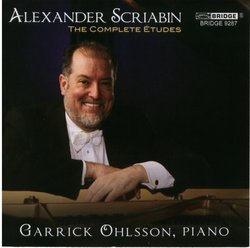| All Artists: Garrick Ohlsson Title: Alexander Scriabin The Complete Etudes Members Wishing: 0 Total Copies: 0 Label: Bridge Release Date: 1/15/2009 Genres: New Age, Classical Styles: Instrumental, Chamber Music, Historical Periods, Classical (c.1770-1830) Number of Discs: 1 SwapaCD Credits: 1 UPC: 090404928727 |
Search - Garrick Ohlsson :: Alexander Scriabin The Complete Etudes
 | Garrick Ohlsson Alexander Scriabin The Complete Etudes Genres: New Age, Classical
|
Larger Image |
CD Details |
CD ReviewsVery recommended for Scriabinian. BigG | BKK, Thailand | 11/28/2009 (5 out of 5 stars) "Mr.Ohlsson performed all pieces on Steinway, Style 4 Concert Grand 1876 which has deeper and sweeter tones, but less clarity than the modern Steinway. I will mention just for Op.2 and Op.8, but Op.49, 56, 65 are all excellent by the way. The first piece is Op.2, No.1 which I have just listened to Richter's and Horowitz's. I give 5 stars for all 3 performings. Op.8 No.1,2,3,4,5 are all excellent. My favorite is No.3. Mr.ohlsson played with a different interpretation than others that I have heard, for example: Pier Lanes, he played with faster tempo and tempest as the piece is marked "Tempestoso", but his tempest is like a chimpanzee turning to rampage compare to Ohlsson which like Gorilla's. Mr.Ohlsson started softly but furious, the B major chord at the bass line is powerful, especially at the ending. For No.5, I heard very few pianist performed this piece. Mr.Ohlsson played it as the same way as Richter's, very beautiful and dramatic. Op.8, No.10 is the combination of chromatic in right hand and wide-ranging in left hand. Here Mr.Ohlsson played the left hand chords loud and powerful.In the ending, the piece is marked ppp, but he played even louder than the middle section, like Mr. Horowitz. The highlight of the set is No.12. He started loud and fast and I heard that he played the 11th chord(D#-G#) in the left hand loud and clearly without rolling. I have heard many pianists playing this piece, but all of them play this chord with rolling. From what I have heard, there are only Ohlsson and Cliburn who can play this chord without rolling. In the middle section his playing is one of the best I have heard. Overall is superb, the beautiful is beautiful and the sorrow is sorrow, but there is a big mistake at time 1:35 and I don't know why they didn't re-record. Scriabin etudes are difficult to understand and some won't be satisfacted you at the first time, but in this set, Mr.Ohlsson can bring out Scriabin's passion and interpretation.It is the best Scriabin etudes set I have heard so far. PS. Sorry for my bad english. I'm not native english, but this the best i can do." Gorgeous Scriabin Playing!! Piano lover Bob | Houston, TX USA | 04/14/2009 (5 out of 5 stars) "Ohlsson truly can play anything, and plays it better than almost anybody. I have heard and read through the years that Ohlsson is known by other pianists as "the pianists pianist". His musical soul can identify with all composers, and his technique can handle the most fiendish virtuoso playing to the most serenely simple melodic passage. These Etudes are challenging on many levels. I happen to have played the c# minor op.2.#1. and the d# min. op.8, #12 - I mention this because I hope I am able to help the reader understand musically and technically what is going on, in case they don't know. The c# min. one is a study in legato (smooth) playing - gliding from one note to the next with no breaks. It also presents counter melodies, harmonies in the left hand - presenting a challenge in how to balance these melodies. The melodies are gorgeous Russian melancholy - ending in beautiful, sad peace. The d# min. is wild!! It starts loud, with flying octaves, in triplet rhythm, in both hands - contrary motion. As the drama opens, the octaves become filled with massive chords - the difficulty (besides hitting the correct notes!)is controlling the SOUND - saving the greatest climax for the massive chordal end! Ohlsson does it perfectly - you just sit back and say "WOW"!!! The entire CD is wonderful." Best Scriabin etudes set so far Christopher Pickert | 04/12/2009 (5 out of 5 stars) "Ohlsson plays this music on an 1876 Steinway. Far from being a gimmick, the piano provides clarity and color across its range, while Ohlsson allows each etude it's own unique character. This makes for a set of etudes that is absorbing all the way through. I don't feel over-saturated by the end of it, as can happen with this music in less-expert hands. This is fantastic playing.
Mr. Ohlsson, we didn't know you were a Scriabinist, but now that you've done this, it's time to record sonatas 6, 7 and 8. Please." |

 Track Listings (26) - Disc #1
Track Listings (26) - Disc #1